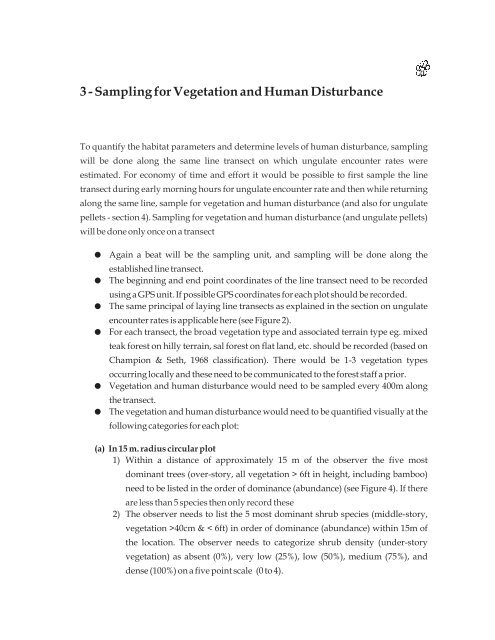FIELD GUIDE Monitoring Tigers, Co-Predators, Prey and their Habitats
FIELD GUIDE Monitoring Tigers, Co-Predators, Prey and their Habitats
FIELD GUIDE Monitoring Tigers, Co-Predators, Prey and their Habitats
Create successful ePaper yourself
Turn your PDF publications into a flip-book with our unique Google optimized e-Paper software.
21<br />
3 - Sampling for Vegetation <strong>and</strong> Human Disturbance<br />
To quantify the habitat parameters <strong>and</strong> determine levels of human disturbance, sampling<br />
will be done along the same line transect on which ungulate encounter rates were<br />
estimated. For economy of time <strong>and</strong> effort it would be possible to first sample the line<br />
transect during early morning hours for ungulate encounter rate <strong>and</strong> then while returning<br />
along the same line, sample for vegetation <strong>and</strong> human disturbance (<strong>and</strong> also for ungulate<br />
pellets - section 4). Sampling for vegetation <strong>and</strong> human disturbance (<strong>and</strong> ungulate pellets)<br />
will be done only once on a transect<br />
<br />
<br />
<br />
<br />
<br />
<br />
Again a beat will be the sampling unit, <strong>and</strong> sampling will be done along the<br />
established line transect.<br />
The beginning <strong>and</strong> end point coordinates of the line transect need to be recorded<br />
using a GPS unit. If possible GPS coordinates for each plot should be recorded.<br />
The same principal of laying line transects as explained in the section on ungulate<br />
encounter rates is applicable here (see Figure 2).<br />
For each transect, the broad vegetation type <strong>and</strong> associated terrain type eg. mixed<br />
teak forest on hilly terrain, sal forest on flat l<strong>and</strong>, etc. should be recorded (based on<br />
Champion & Seth, 1968 classification). There would be 1-3 vegetation types<br />
occurring locally <strong>and</strong> these need to be communicated to the forest staff a prior.<br />
Vegetation <strong>and</strong> human disturbance would need to be sampled every 400m along<br />
the transect.<br />
The vegetation <strong>and</strong> human disturbance would need to be quantified visually at the<br />
following categories for each plot:<br />
(a) In 15 m. radius circular plot<br />
1) Within a distance of approximately 15 m of the observer the five most<br />
dominant trees (over-story, all vegetation > 6ft in height, including bamboo)<br />
need to be listed in the order of dominance (abundance) (see Figure 4). If there<br />
are less than 5 species then only record these<br />
2) The observer needs to list the 5 most dominant shrub species (middle-story,<br />
vegetation >40cm & < 6ft) in order of dominance (abundance) within 15m of<br />
the location. The observer needs to categorize shrub density (under-story<br />
vegetation) as absent (0%), very low (25%), low (50%), medium (75%), <strong>and</strong><br />
dense (100%) on a five point scale (0 to 4).

















